Apple's iPhone 4: Thoroughly Reviewed
by Brian Klug & Anand Lal Shimpi on June 30, 2010 4:06 AM EST- Posted in
- Smartphones
- Apple
- iPhone 4
- Gadgets
- Mobile
I'm not sure how this keeps happening. The first year I waited at a mall for 5 hours to get the original iPhone. The following year my friend Mark Rein convinced me to see a midnight showing of Hellboy II and then wait outside of an AT&T store all night to get the iPhone 3G. You'd think I'd learn by the third year but once more I was in line at the mall hours before the Apple store opened to get the 3GS. This year I thought it would be different. Apple offered free overnight shipping to anyone who wanted to pre-order the iPhone 4. Figuring everyone would go that route I decided to beat the FedEx trucks and just show up at the mall at 6AM. I'd be in and out in a little over an hour, which would give me a head start on battery life testing on Apple's 4th generation iPhone.
I promise that not all of my decisions play out this poorly. Those who pre-ordered the 4 and requested overnight delivery got their phones early and my one hour wait turned into six hours at the mall, for the fourth year in a row.
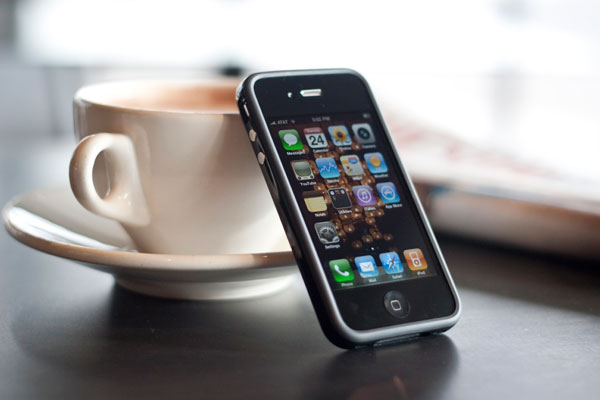
Apple's iPhone 4 with Bumper Case
It's a self fulfilling prophecy. Steve gets up on stage, proclaims the iPhone 4 to be the biggest introduction since the original iPhone, and the public flocks to Apple stores to fork over $200 on day one and around $2500 over the course of two years for the privilege. But this isn't 2007. Apple has real competitors in the smartphone space. Android phones have grown in features, polish and popularity. Even Palm entered the race with a competant offering, and Microsoft isn't far behind. It's easy to start a revolution when everyone else is doing the wrong thing, but what about when more companies actually get it? Was Steve justified in his excitement over the 4? That's what we're here to find out today.
Straight on it looks like just another iPhone. You get the black face with a shiny trim. From the side it is the redesign that Apple has needed for a while now. It’s not revolutionary but it’s the type of improvement that makes its predecessor feel old. And that’s exactly what this does. Have a look for yourself:
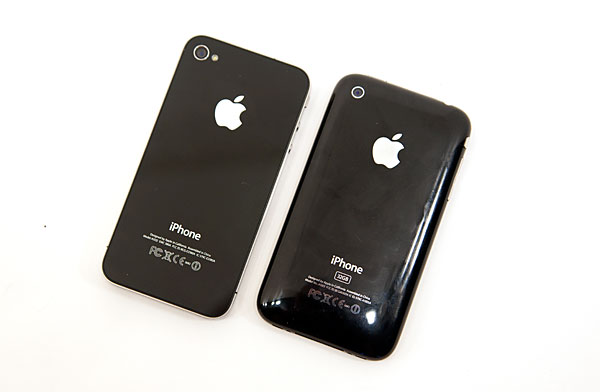
iPhone 4 (left) vs. iPhone 3GS (right)
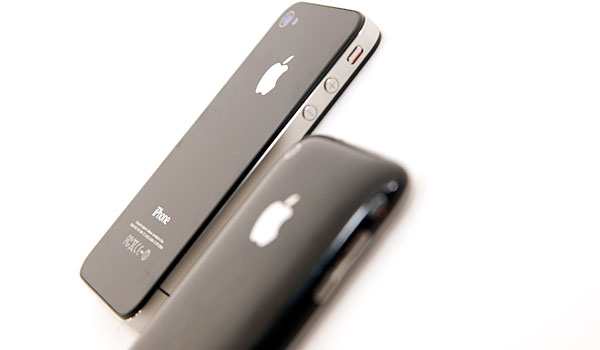
The straight lines, smaller dimensions and lack of unnecessary bulk make the 3GS feel like a car from the 90s, unnecessarily curvy. The styling is now so much more compact. Compared to the iPhone 3GS the 4 is around 5% narrower (but no more difficult to type on) and nearly 25% thinner. It even makes the Nexus One look dated:
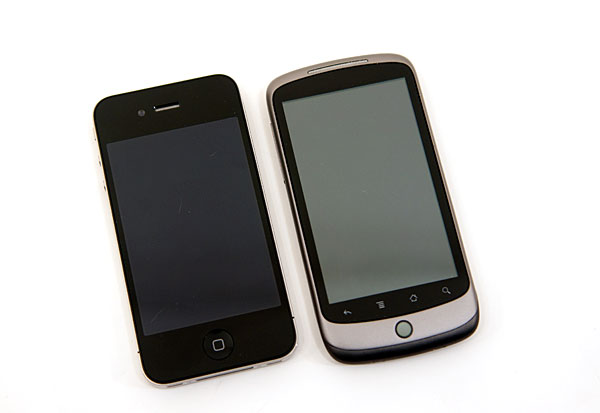
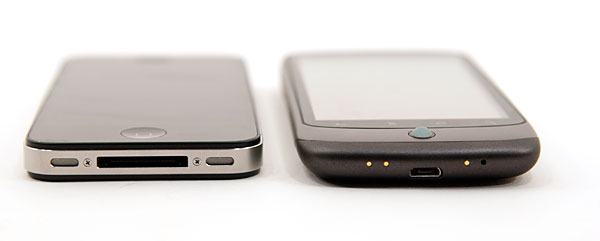
The iPhone 4 is slightly heavier than the 3GS (4.8oz vs. 4.7oz). You feel the added weight but I wouldn't call it heavy. The front and the back of the iPhone 4 are both made out of glass, and they protrude beyond the stainless steel band that wraps around the phone (more on this controversial decision later). While this gives the 4 an amazing finish, it also makes carrying the phone nerve racking. Coupled with the smaller, more dense form factor I’m now deathly afraid of dropping and shattering this thing. Apple has done a lot to reinforce the glass, however there have been enough reports already of shattered iPhone 4s for me not to feel very safe. Only Apple would think to make the two surfaces most likely to hit something out of glass. It's like making mouse traps out of cheese, something bad is bound to happen.
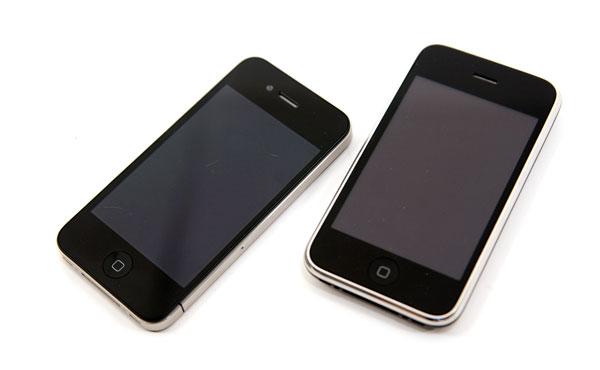
iPhone 4 (left) vs. iPhone 3GS (right)
The physical buttons (but not their layout) have changed on the 4. The ringer switch has shorter travel and feels sturdier as a result. The volume rocker has been replaced by discrete volume up/down buttons, also very sturdy in feel. The power/lock button is also now made out of stainless steel. Only the home button remains unchanged, although it does seem to make a deeper click when you use it.

The speaker moved to behind the right grill at the bottom of the phone instead of the left. The dock connector thankfully remained unchanged. It looks like Apple is committed to maintaining this connector until it makes the jump to something wireless (or optical?).

The back of the phone is pretty. Apple broke with tradition and finally included a single LED flash on the phone. The flash comes on in low light conditions and is enough to take shots in total darkness.
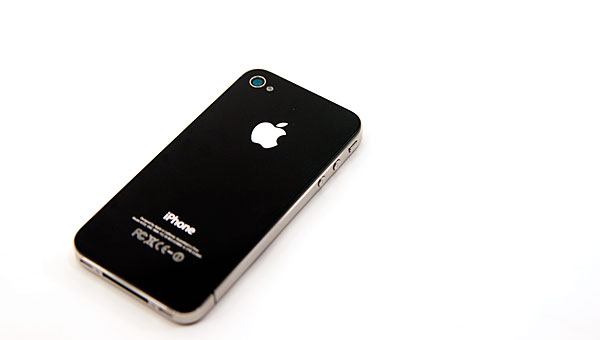
The camera has been upgraded to a low noise 5MP sensor. It can shoot stills at up to 2592 x 1936 or video at 1280 x 720 @ 30 fps. We’ll go into greater detail on its quality in the camera section. The iPhone 4 also adds a front facing camera capable of shooting both photos and video at 640 x 480.
Apple quotes contrast ratio as 1000:1, in our measurements we got very close (952:1). A significant improvement over the 188:1 ratio of the 3GS. Apple achieved this by both dropping black levels and increasing the white levels on the display. Improving both is always fine by me.
Internally the iPhone 4 uses Apple's new A4 SoC, built around an ARM Cortex A8 CPU and a PowerVR SGX GPU. The new SoC is built on a 45nm process and features 512MB of memory on the package. Apple hasn't made CPU clock speed public, but I'm guessing around 800MHz compared to the iPad's 1GHz for reasons you'll see later. GPU clock speed is unknown as well. Having more memory on package is an interesting move by Apple as it makes the iPhone 4 better suited for multitasking compared to the iPad. Also implying that shortly after the iPad gets multitasking it'll be updated to a version with more memory as well.
The iPhone now has an gyroscope as well the rotation sensors of its predecessors. Developers are given full access to the gyroscope making the iPhone 4 capable of becoming a very expensive Wii-mote.
| Physical Comparison | ||||||||
| Apple iPhone 4 | Apple iPhone 3GS | HTC EVO 4G (Qualcomm Snapdragon QSD8650) | HTC Droid Incredible (Qualcomm Snapdragon QSD8650) | Google Nexus One (Qualcomm Snapdragon QSD8250) | ||||
| Height | 115.2 mm (4.5") | 115 mm (4.5") | 121.9 mm (4.8") | 117.5 mm (4.63") | 119 mm (4.7") | |||
| Width | 58.6 mm (2.31") | 62.1 mm (2.44") | 66.0 mm (2.6") | 58.5 mm (2.30") | 59.8 mm (2.35") | |||
| Depth | 9.3 mm ( 0.37") | 12.3 mm (0.48") | 12.7 mm (0.5") | 11.9 mm (0.47") | 11.5 mm (0.45") | |||
| Weight | 137 g (4.8 oz) | 133 g (4.7 oz) | 170 g (6.0 oz) | 130 g (4.6 oz) | 130 g (4.6 oz) | |||
| CPU | Apple A4 @ ~800MHz | Apple/Samsung A3 @ 600MHz | Qualcomm Scorpion @ 1GHz | Qualcomm Scorpion @ 1GHz | Qualcomm Scorpion @ 1GHz | |||
| GPU | PowerVR SGX 535 | PowerVR SGX 535 | Adreno 200 | Adreno 200 | Adreno 200 | |||
| RAM | 512MB LPDDR1 (?) | 256MB LPDDR1 | 512MB LPDDR1 | 512MB LPDDR1 | 512MB LPDDR1 | |||
| NAND | 16GB or 32GB integrated | 16 or 32GB integrated | 8GB micro SD | 8GB micro SD | micro SD | |||
| Camera | 5MP with LED Flash + Front Facing Camera | 3MP | 8MP with dual LED Flash + Front Facing Camera | 8MP with LED Flash | 5MP with LED Flash | |||
| Screen | 3.5" 640 x 960 LED backlit LCD | 3.5" 320 x 480 | 4.3" 480 x 800 | 3.7" 480 x 800 AMOLED | 3.7" 480 x 800 AMOLED | |||
| Battery | Integrated 5.254Whr | Integrated 4.51Whr | Removable 5.5Whr | Removable 4.81 Whr | Removable 5.18 Whr | |||
The iPhone 4's logic board shrinks in size thanks to further component integration, making room for a much larger battery. The 5.25Whr battery in the iPhone 4 is a 16% increase from what was in the 3GS, and 95% of what HTC put in the EVO 4G. While raw performance improved, it's clear that Apple's focus this time around was battery life. Again, we'll dive into specifics later in the review.
Moving back outside Apple surrounded the phone with a stainless steel band. This band doubles as the 3G, WiFi and Bluetooth antennas. And if you hadn't noticed, it also moonlights as a giant elephant. Let's talk about it.










270 Comments
View All Comments
MacTheSpoon - Wednesday, June 30, 2010 - link
Hi, thanks for a really great review (I hope this isn't a double post, I had a problem when I submitted this before). I especially liked the hard numbers you used to measure things. Seeing the screen black levels, brightness, and contrast, plus how they compared to other phones, was really wonderful. I did have a few questions:1. Are you sure it's reasonable to conclude the maximum drop in signal strength when holding the phone is 24 dB? Doesn't skin capacitance vary from person to person? Also, I've seen some people put keys on their phones to connect the two antenna and demonstrate the reception problem, and I wonder if you could consider measuring the dB effect for that as well. Considering that keys are often kept in pockets with cellphones and could rest against the phones it seems like a reasonable scenario to explore.
2. Did you mention the problems people have had with the glass shattering easily? I've read many reports of this online. I didn't notice it but perhaps I did not read closely enough.
3. Since a case is, as you say, a must-have accessory for the phone, not only for the antenna but also apparently for the brittle enclosure, it seems unfair to give the phone credit for being 9.3 mm thin. Could you please give the thickness of the phone with the bumper? That seems to be its real thickness to me, honestly.
Thanks again for the review!
PhilBrandn - Wednesday, June 30, 2010 - link
See this video:http://vimeo.com/12951893
Even replicating the problem doesn't seem to force a dropped call.
MacTheSpoon - Wednesday, June 30, 2010 - link
It does, actually. Check this out:http://www.youtube.com/watch?v=03PQyWp0mWE
bill4 - Wednesday, June 30, 2010 - link
Cant shake the feeling of overwhelming Apple bias from most tech sites, and Anandtech.It doesn't help that it seems every tech editor's personal phone is an iPhone. And that's most certainly not because it's better, in fact in most cases the iPhone is objectively inferior to other phones.
This line in the article:
"On top of the battery life improvements Apple finally plays catch up and surpasses the technological advancements in its Android competitors. The 4's camera is as good as it gets today and the screen is a beauty. I don't believe this advantage will last for the lifetime of the iPhone "
Battery life is routinely massively overrated by Anand, it's simply not as important to most people as it seems to be to Anand. Charge your phone each evening and it's done. What's the big deal? Seems like the unnatural battery life obsession is just a way to give fake props to Apple in every review.
Likewise, "surpasses the technological advancements in its Android competitors. " Huh? Not hardly bud. By far the most important metric these days is screen size. Yes, it's probably not politically correct to say, I should talk about "usability" or some other subjective thing so we can pretend Apple is the winner, but it's the hard truth. Android phones have 4.3" and 4" screens aplenty. That's why I'm way more excited over the Evo, the Droid X, the Galaxy S, then a lame 3.5" iPhone revision. The iPhone 4 screen is actually (slightly) smaller than the 3GS screen (though they're both nominally 3.5" in screen area the 4 screen is smaller than the 3GS screen)! (Funny Anand never mentioned this fact once). Apple actually went BACKWARDs in this crucial area.
Then we have the weak 800mhz CPU vs the 1ghz+in many android models, etc etc.
Then we have the camera, worse in all respects to top droid phone cameras.
So in every relevant area except a currently meaningless one (resolution), the iPhone 4 objectively has worse specs than top Droid phones, already, yet Anand says it "surpasses the technological advancements in its Android competitors". OK, no bias there...
Overall, I just wish more reviews would call the 4 what it is, a small revision to the 3GS that falls short. Apple should have named it the 3GS+, it certainly doesnt deserve true succesor status. Hell, when sitting side by side, it's actually difficult to tell the 3GS and 4 apart, I guarantee no casual female (like, a Mom) could do it offhand. Your mom literally would not know which is supposed to be the "new" iPhone!
The Retina display is so much marketing BS. It's a small, typical incremental, completely non-revolutionary bump in resolution, yet dishonest tech sites are proclaiming it like it's somehow something tangibly new. More screen size would have been far more useful, the high PPI is truly almost completely useless compared to other 800X480 android phones, which are more than fine in that area as is. What's coming next Apple, 1080P on a 2.5" screen on the iPhone 5? Makes about as much sense. Screen size is objectively far, far more important than resolution on these phones, at least if they're 800X480 or above.
In the end I see another year of Apple losing share to the Droid phones, the 4 is a very minor change to the 3GS. Maybe next year Apple will do better.
I'm a good example, I'm limited to ATT, so I have few options, even though I dislike Apple, the iPhone 4 seemed like a good choice for me (only other option being the unsubsidized 529 Nexus One currently!), yet, there's just no way I'm going to settle for the no flash, small screen, iPhone 4.
kmmatney - Wednesday, June 30, 2010 - link
"And that's most certainly not because it's better, in fact in most cases the iPhone is objectively inferior to other phones."You pretty much lost your credibility right there..
About the battery life issue - it's huge - at least with people who travel a lot, like me. And I'm not about to carry an extra battery around.
JAS - Wednesday, June 30, 2010 - link
The iPhone 4 is a significantly greater upgrade over the 3GS than the 3GS was over the iPhone 3. The new A4 processor and doubling of the RAM make the iPhone 4 a noticeably faster device. Its improved camera and 720P video recording are additional noteworthy plusses.Yes, the Google Android OS is bound to be running on more smart phones than the Apple iOS by virtue of the fact that Andriod phones are available from more manufacturers and wireless carriers. The situation is not unlike the great abundance of computers that run Microsoft Windows versus the number of OS X Macintoshes in use. Only Apple sells Macs while MS Windows boxes are available from a wide range of manufacturers.
strikeback03 - Thursday, July 1, 2010 - link
Well the first phone I know of with a 4"+ screen was the HD2, but as it runs Windows Mobile that rules it out for a lot of people. In the US at least I don't think there are any 4" or bigger screens actually released other than the EVO, the Droid X doesn't come out for another few weeks and the Galaxy S class (shouldn't these have been named the Galaxy, Yamato, Enterprise...) do not have a firm release date yet.On the subject of battery life, if the phone cannot make it through your day (as he states previous iphones could not make it through his) then that can be a problem. Sure I would prefer a phone that can go 3 or 4 days without recharging, but until battery technology allows that to be pocketable I will live with lasting a full day. But if I start needing to have a charger at work and in my car just to make it through the day that is a problem. I do wish he would have some type of a more mixed battery life test though, after all I don't know anyone who is just going to sit and browse the web over 3G very often. How about a mix of (per hour) 10SMS, 3 min on voice call, 5 min web browsing, 5 min gaming, 5 min listening to music, checking email 4 times, and the rest of the time just flicking the screen on occasionally to check the time, or calendar, or a sports score, etc? How long could it last in a more general use scenario like that?
Mumrik - Friday, July 2, 2010 - link
"Battery life is routinely massively overrated by Anand"I can't get my head around why you'd ever say something like that. Having to recharge every night is a major hassle and completely unacceptable. We don't all sleep the same place every night or want to keep our chargers by the bed. Battery life is a huge issue right now as companies put more and more powerful and power consuming chips in phones while batter life suffers. It used to be normal to recharge you phone 1-2 times a week you know...
ale087 - Wednesday, June 30, 2010 - link
I see the Galaxy S as a direct competitor to the iPhone 4, the SoC has been said to be extremely similar... Please give us an in-depth review with awesome hardware info that we can't get anywhere else :-D Thanks for doing a great job as always! looking forward to that Galaxy S review ;-)navderek - Wednesday, June 30, 2010 - link
Are you really sure you know what your talking about when it comes to reviewing RF related topics? You seem to know the basics but I don't think you know enough to actually review handsets in this manner and your comments can be misleading.I work in the RF field as an RF Operations Specialist for a several large network that include iDEN, CDMA, and UMTS, as well as microwave and fiber optic transmission. Anyways this is not about me but I thought I would state this before continuing...
The signal bars do not always simply signify signal strength in decibels. For many handsets what the actually signify is signal QUALITY. This could be SNR as you mentioned in your article however it is not so simple...
For example, in an iDEN network the quality measurement is "SQE" and for a UMTS network (or as we like to call it - 3G network), the first and foremost quality measure is "CQI"
Lets use the CQI metric in UMTS for our example...CQI values will determine the coding technique used by the serving BTS (tower) which will determine how many redundant bits to send to keep the BER low as well determine which modulation scheme to use (i.e. different levels of QAM, like 64QAM in the best quality scenario).
Now I won't go into detail here about how all this works and how it's tied into the graphical representation of the bars you see on the handset but I will let you in on something...over the years those bars have become less and less reliable as a measure of signal strength and/or quality. Why? Because cellular carriers don't want clients to see less than 5 bars, so they have been pretty much rigged to display 5 bars in most situations until the signal is VERY BAD.
Finally, about your coments in regards to signal strength in decibels...-107dB is extremely
bad for a signal on any network. You stated that for voice and data that -107dB is perfectly fine...this could not be further from the truth and this is the point where the signal levels out with the noise floor. The BTS and/or UE begin to really lose communication with eachother at this level and on top of that you'll never get good data rates at such a poor signal level with UMTS for reasons stated above. At that signal level (-107dB) the BTS will be sending a ton of redundant bits with the most redundant coding technique as well as factoring down the QAM constallation in an attempt to keep the link alive. The data may still work in some cases at -107dB but your speeds will suffer GREATLY.
Please consider hiring an RF expert before making generalized RF based reviews. I highly respect your reviewing cabability and your intelligence, however I question your wisdom when you do such a review.
Thanks